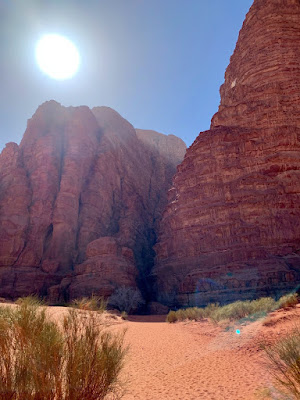In the picture above, you can see the imposing and distinct seven pillar formation behind the reception amenities at the entrance to Wadi Rum. British officer T.E. Lawrence passed through Wadi Rum several times while serving during the Arab Revolt of 1917-18. In 1922, Lawrence published his autobiographical account The Seven Pillars of Wisdom about his time spent serving in the British army as a liaison officer. In the 1980s this large rock formation originally known as Jabal al-Mazmar (Mountain of the Plague) was renamed the Seven Pillars.
Above and below are pictures I took when we stopped to see a water source hidden back in the sandstone rocks, used for century upon century by the local Bedouins. This is Khazali Canyon, where we were also able to climb a bit back into the rocks to see some of the ancient rock paintings and graffiti carved over millennia. It includes Thamudic, Nabatean and Islamic inscriptions as well as petroglyphs. These petroglyphs include feet - see the pic. At the end of this canyon are several man-made rock cut basins for the collection of water.
Our last full day in Jordan was spent at a resort along the Dead Sea. But first we took a quick car tour through the seaside city of Aqaba for a look-see into a mosque. Aqaba is located on the Gulf of Aqaba, off of the Red Sea, and it was really pretty and modern.
We stopped at the entrance to the mosque grounds to borrow appropriate head coverings to be allowed a look inside. This isn't an historic mosque, but it was beautiful and we were happy to have the chance to tour a mosque in Jordan with our Muslim guide Nidal.
Not wanting to fall behind with my Bible study class lessons while on this amazing trip, I brought my Warren Wiersbe commentary on 1&2 Thessalonians and read it in a cabana out by one of the three pools on the property with a lovely view of the Dead Sea. We had the added bonus of Israeli fighter jets zipping by over the water... very low, loud and visible.
























No comments:
Post a Comment